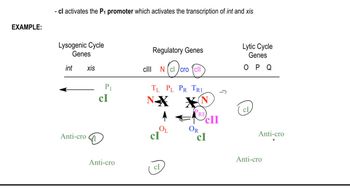Here are the essential concepts you must grasp in order to answer the question correctly.
Lytic and Lysogenic Cycles
The lytic and lysogenic cycles are two distinct pathways that bacteriophages, like λ phage, can follow after infecting a host bacterium. In the lytic cycle, the phage replicates rapidly, leading to the destruction of the host cell and the release of new phage particles. In contrast, the lysogenic cycle involves the integration of the phage DNA into the host genome, allowing it to replicate along with the host cell without causing immediate harm.
Recommended video:
Decision Between Lytic and Lysogenic Cycles
cII Protein
The cII protein is a key regulatory protein in λ phage that promotes the lysogenic cycle. It activates the transcription of genes necessary for lysogeny, including the repressor protein cI, which maintains the phage in a dormant state within the host. If cII is inactivated by mutations, the phage is more likely to enter the lytic cycle due to the lack of lysogenic promotion.
Recommended video:
cro Protein
The cro protein is another regulatory protein in λ phage that plays a crucial role in determining the lytic cycle. It represses the expression of the cI gene, thereby favoring the lytic pathway. Mutations that inactivate cro can lead to increased levels of cI, promoting lysogeny and preventing the lytic cycle, as the phage would be unable to effectively suppress the lysogenic state.
Recommended video:
 Verified step by step guidance
Verified step by step guidance Verified video answer for a similar problem:
Verified video answer for a similar problem:



 4:29m
4:29m